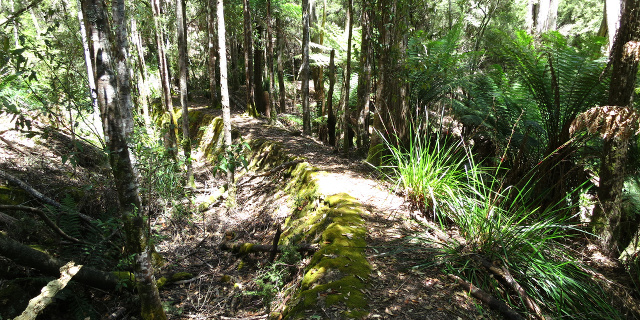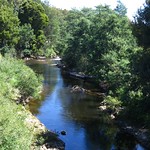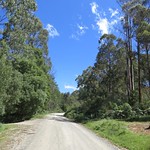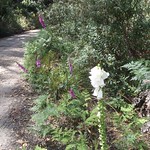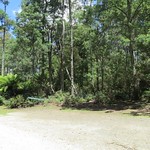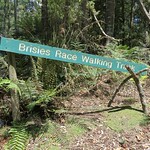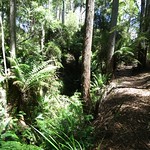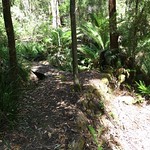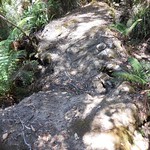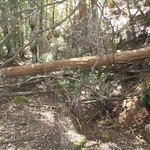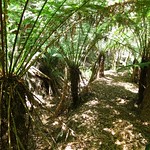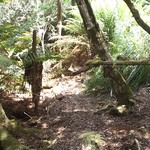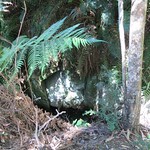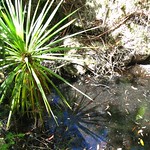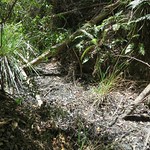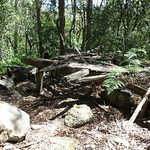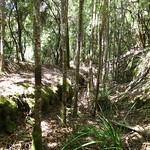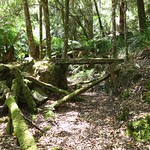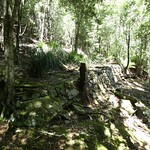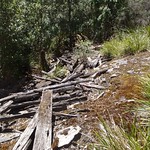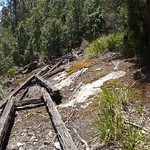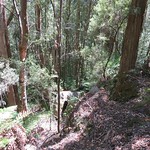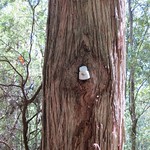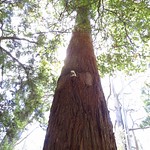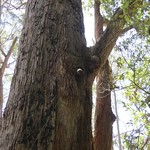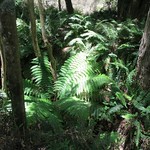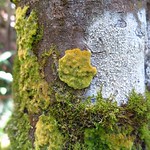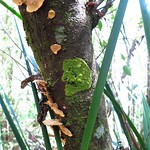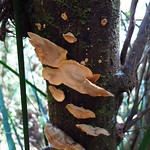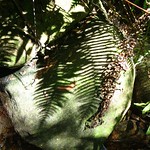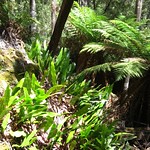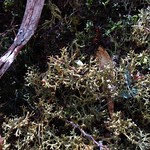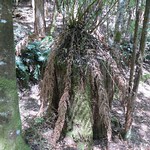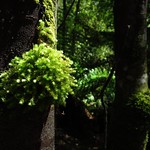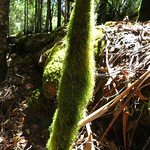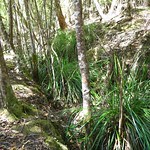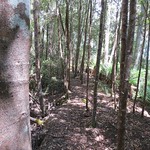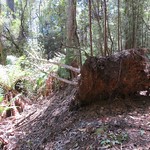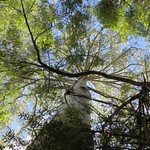The Briseis Water Race (sometimes described as “The Great Briseis Water Race” or just “The Great Briseis Race”) transported water from Ringarooma to the Briseis Tin Mine at Derby. Built between 1901 and 1902, it was an immense engineering effort for its time, covering 48 kilometres, employing 300 workers and costing £60,000.
Most of the race is on private land, overgrown or otherwise inaccessible; part is still in use to bring water to the Branxholm Reservoir. Fortunately an unused section of the race at the town of Branxholm has been set aside for a walking track.
Getting There
Driving to Branxholm from most parts of Tasmania is simple. However, it can be time-consuming due to the winding roads in its area. Once there, we turned south onto Donald Street. This became Ruby Flats Road, which was unsealed for about two kilometres to the car park.
Track
Finding the track from the car park was a small challenge. We found that it was a narrow green path next to the track sign. Once it met the race, the track became wider and straighter. However, following the race also meant walking beside a four-metre-deep trench with vertical sides, terminating in malevolent black water of unknown depth.
The track was good until the second historical sign (titled “An Engineering Challenge”, around 700 metres from the car park). From them on it became less distinct, sections had collapsed and trees had occasionally fallen across it. None of us reached an obvious end point to the track; it just became too hard to follow.
The water race followed a gradient of four feet per mile (1:1320), so the track alongside was also mostly level.
The Race
The race was quite varied. Near the car park it was a deep trench, contained black water and was surrounded by ferns. As we walked the trench became shallower, the water turned to mud and then dead leaves, and the ferns gave way to grass trees and then shrubs. Then the trench opened into a space where it once ran in a wooden flume on a trestle. While this structure no longer stood, decaying wood and rusting bolts showed where it ran.
Artefacts
A sign at the start of the walk mentions some remains to look out for.
Thirty minute return walk will give an insight to the fever and confidence of the mine managers and owners, compelling them to embark on this outstanding engineering feat. You can see signs of history along the way:
- Deep four metre cutting through solid rock.
- Sections of original stonewalling.
- Insulators and the single strand telephone wire that ran the length of the Race, for use in emergencies.
- Sections of timber wrestling and fluming structures built to transport water.
- Marker pegs indicating the miles and chain distances measured from the mine.
- Tree stumps with “shoes” where planks were inserted for tree fallers to stand on to saw through the tree.
Apart from the race and flume, which are hard to miss, we saw the three telegraph insulators (look up at the tree trunks) and one logging shoe.
Plants
This part of the race ran through dry forest, full of eucalypts and smaller shrubs. Despite this, the race was surrounded by ferns, from giant treeferns, through the knee-high hard water fern, to the tiny kangaroo fern. Possibly the race still soaks up enough water to keep the ferns growing.
The trees supported a moderate amount of moss, lichen and fungi.
The only flower in evidence was a grass trigger plant (Stylidium graminifolium).
Facilities
| Road | Unsealed for about two kilometres. The first kilometre to the tip is good; once past that point it is poor. |
|---|---|
| Parking | Small |
| Shelter | No |
| Toilets | No (go to Branxholm) |
| Latest visit | 29th December 2013 |
Opinions
Walking Stick
The walk to the second historical sign was a very comfortable stroll, although not quite flat enough for wheels. The track beyond that point was too rough for comfort.
Ambler
Walked 2.7 km in 1:33. Turned back at the second long flume section due to shortage of time. Fallen trees were inconvenient but not insurmountable.
Racewalker
Experienced no difficulty walking until the track become too indistinct to follow.
Should I Visit?
If you like some history mixed into your bushwalks, this is an excellent short walk. For a day of history and walking, visit both the Mount Paris Dam and Briseis Water Race.
If you like level walks along old logging tramways and railway cuttings, this is also a good choice.
If you expect some variety in your vegetation, the Briseis Water Race may seem repetitive.
We do not recommend taking children who require ongoing supervision to the race, due to its depth near the car park.
References
Forestry Tasmania – Briseis Race Walking Track
